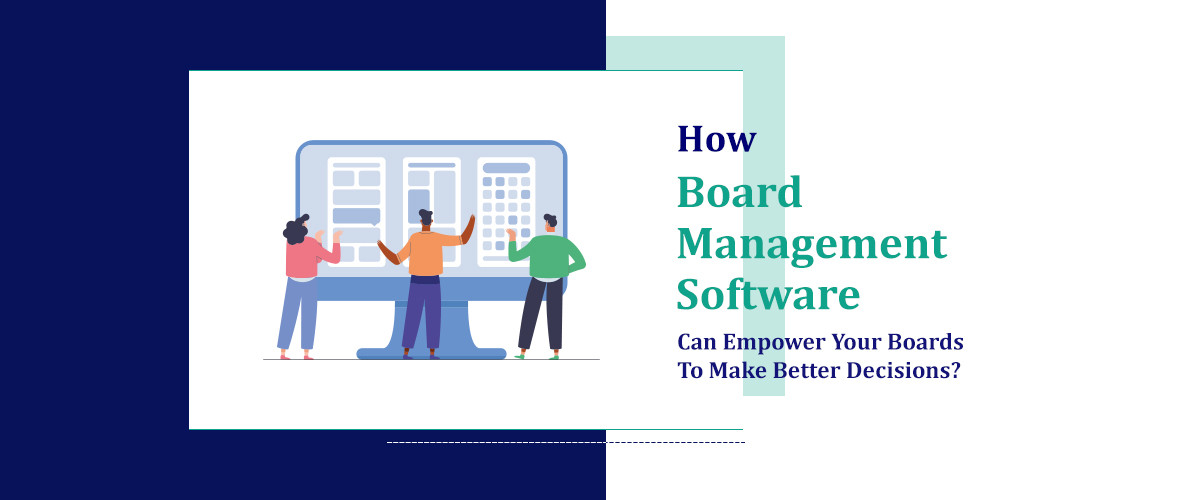What we'll cover
Any organization's ability to succeed in the fast-paced business environment of today depends on its ability to make wise judgements. Corporate leaders, decision-makers, and board members are essential in determining how their organisations will develop in the future. Many organisations are using Board management software to strengthen the decision-making capacities of these important stakeholders and to empower them. This effective tool promotes teamwork, centralises document management, and simplifies communication. We'll look at how board management software may improve organisational decision-making and lead to greater results in this blog article.
What is Board Management Software?
Board management software is a cutting-edge technical solution that helps board members of an organisation collaborate and communicate with each other more easily. It is mostly utilised in the United States and other locations. It offers a safe space for exchanging private papers, setting up Meeting software, taking votes, and promoting dialogue. The purpose of this programme is to guarantee adherence to corporate governance guidelines, optimise decision-making procedures, and increase the effectiveness of board activities.
The need for effective board cooperation and communication has grown significantly in recent years, which has led to a major increase in the use of board management software. Organisations are using technological solutions like Board Management Software to simplify their board operations as remote work and virtual meetings become more common.
Understanding board management software's definition and uses is crucial. A digital platform called board management software was created especially to make the job of executive teams and boards easier. It acts as a focal point for board members' and executives' cooperation, document exchange, and communication. This programme provides a safe and easily accessible platform for decision-making processes by combining important data and resources.
Who Uses Board Management Software?
In the US, many different types of organizations mostly those run by boards of directors use board management software. This covers businesses, charitable organisations, academic institutions, and governmental bodies. Board members may communicate, collaborate, and make decisions more efficiently with the help of these platforms, which include secure document sharing, meeting scheduling, voting, and other features. This software facilitates effective remote involvement and engagement, which is especially advantageous for organisations whose board members are spread geographically.
Furthermore, a lot of these platforms include built-in tools to help with adhering to rules and policies regarding board governance.Software for board management is an essential tool for businesses trying to increase productivity and efficiency in general. In the current dynamic business landscape, it is of utmost significance for organisations to guarantee that all relevant parties are in agreement and striving towards shared objectives.
This includes board members, who are crucial in determining an organization's strategic course. Organisations may guarantee that the members of their board have quick access to all relevant information and documents by using board management software. This facilitates informed decision-making and efficient communication.The capacity of board management software to facilitate communication and teamwork among members is one of its primary advantages. Board members don't need to schedule several emails or in-person meetings to discuss crucial topics, view vital papers, and make decisions thanks to features like secure document sharing and real-time messaging. This improves efficiency and transparency within an organisation in addition to saving time.
Benefits of Board Management Software
Using board management software has several advantages that enable board members and decision-makers to reach well-informed and practical conclusions. Let's examine a few of these benefits:
-
Simplified Interaction
The use of board management software greatly enhances stakeholder, executive, and board member communication. It permits instantaneous sharing of crucial documents, secure messaging, and real-time updates. Board members may have fruitful talks and quickly come to an agreement thanks to features like discussion forums and vote tools.
-
Document Management in One Place
The days of going through piles of paper are long gone. With the help of board management software, papers may be managed and stored centrally, guaranteeing quick access to important data. Financial reports, board books, meeting minutes, and other important documents may be arranged, exchanged, and kept safely with the right authorization. By giving board members rapid access to pertinent information, this expedites the decision-making process.
-
Improved Cooperation
Executives and board members must frequently work together to make decisions that are effective. Board management software allows for real-time document editing, version control, and Applicant tracking system, which promotes smooth cooperation. This encourages the exchange of ideas, their refinement, and eventually their transformation into choices that have a significant influence.
-
Enhanced Safety and Adherence
Security and compliance are given top priority in board management software. It provides strong encryption techniques to safeguard private data. Permissions and access restrictions guarantee that confidential documents may only be viewed or edited by authorised personnel. Additionally, features like audit trails and data retention policies that facilitate compliance with industry standards and regulatory requirements are frequently included in board management software.
Considerations for Choosing Board Management Software
It is important to take into account a number of important considerations while choosing board management software for your company:
-
Important characteristics: Search for software that provides necessary functions including encrypted communications, document management, voting tools, and cross-platform accessibility.
-
Combining with Current Systems: Make sure the programme works well with any other systems your company may have, such collaboration tools or document management systems.
-
Scalability and User-Friendliness: Select software that grows with your company to meet its demands. Additionally, user-friendliness is necessary to guarantee that all stakeholders embrace it quickly and use it effectively.
What Types of Board Management Software Are There?
A variety of board management software options are available, especially in the US market, to help with board cooperation and communication.
Board Portal Software: This kind of software gives board members a safe space to work together on board-related projects, access board materials, and have private conversations.
Meeting management software: With features for agenda creation, minute taking, and action item tracking, this programme simplifies the process of organising and running board meetings.
Software for document management: This programme helps with the administration of board papers by making sure they are safely kept, readily available, and shareable with the right people.
Task management software: By making it easier to monitor and handle board assignments, this software improves accountability and guarantees that every work is finished on schedule.
Software for Governance, Risk, and Compliance (GRC): This software offers tools for policy management, risk assessment, and compliance tracking, assisting boards in managing governance, risk, and compliance challenges.
Boards now depend on these kinds of technologies more than ever as they manage the growing duties and complexity of controlling principles. Board management software has developed to incorporate capabilities like electronic signatures, virtual voting, and real-time communication in line with the growth of digital transformation. Because of this, it is now simpler for boards to operate effectively even when their members are spread out geographically.
Board Management Software Trends
Board management software trends in the US are changing to reflect the increasingly distant and digital character of corporate governance. A rising number of board members are using artificial intelligence (AI) and machine learning to swiftly analyse large volumes of data and reach well-informed conclusions. Furthermore, there is an increasing need for mobile access to board documents, which reflects the modern fast-paced corporate environment's requirement for continual connectivity and flexibility. Strong security measures are an essential component of any Idea management software, as they safeguard critical company data. Cybersecurity is another area of great importance. Last but not least, there is a clear trend towards integration as businesses look for software that works well with their current tools and systems.
Additionally, corporate boardrooms have placed a greater focus on inclusiveness and diversity in recent years. Organisations are searching for software that helps them achieve their diversity and inclusion initiatives inside their ranks. Board management software is getting more and more popular with features like accessibility choices for people with impairments and bilingual capability.
The transition of board meetings to paperless sessions is another noteworthy development. An rising number of businesses are choosing digital solutions that do away with the requirement for tangible papers in light of the growing emphasis on sustainability and cutting down on paper waste. This change helps the environment and simplifies meeting procedures by facilitating simple sharing, teamwork, and instantaneous board content changes.
Implementing Board Management Software
Careful preparation and execution are necessary when using board management software. To guarantee a seamless deployment process, follow these procedures and best practices:
-
Needs Evaluation: To locate board management software that supports your objectives, determine the particular demands and specifications of your company.
-
Instruction and Acclimatisation: Make sure that all executives and board members are familiar with the programme and know all of its features by offering thorough training and onboarding sessions.
-
Continued Assistance: Provide resources and continuous assistance to handle any queries or issues that may come up throughout the software's adoption and use.
You may optimise board management software's advantages and provide your boards more decision-making authority by adhering to these guidelines and best practices.
Conclusion
Effective decision-making is the cornerstone of organizational success. By embracing board management software, companies can enhance communication, centralize document management, foster collaboration, and improve overall governance. The Board Management Software SaaS Adviser platform stands as a robust, intuitive, and comprehensive solution for businesses seeking to streamline their operations. Its capacity to facilitate effective and efficient board management makes it a standout choice in the realm of SaaS offerings. By offering a seamless interface, powerful features, and reliable support, it effectively meets the diverse needs of its users, affirming its position as a leading player in the software listing space
Board management software is a digital platform that facilitates board meetings, document sharing, collaboration, and decision-making processes for corporate boards.
It centralizes communication, streamlines document management, ensures secure access to critical information, and facilitates transparent decision-making processes.
Common features include agenda management, meeting scheduling, document distribution, voting tools, annotations, and secure messaging.
It enables real-time access to documents, allows for remote participation in meetings, and provides tools for discussion and decision-making, fostering collaboration among board members.
Yes, it promotes transparency, accountability, and compliance by providing a centralized platform for documentation, discussions, and decision records.




